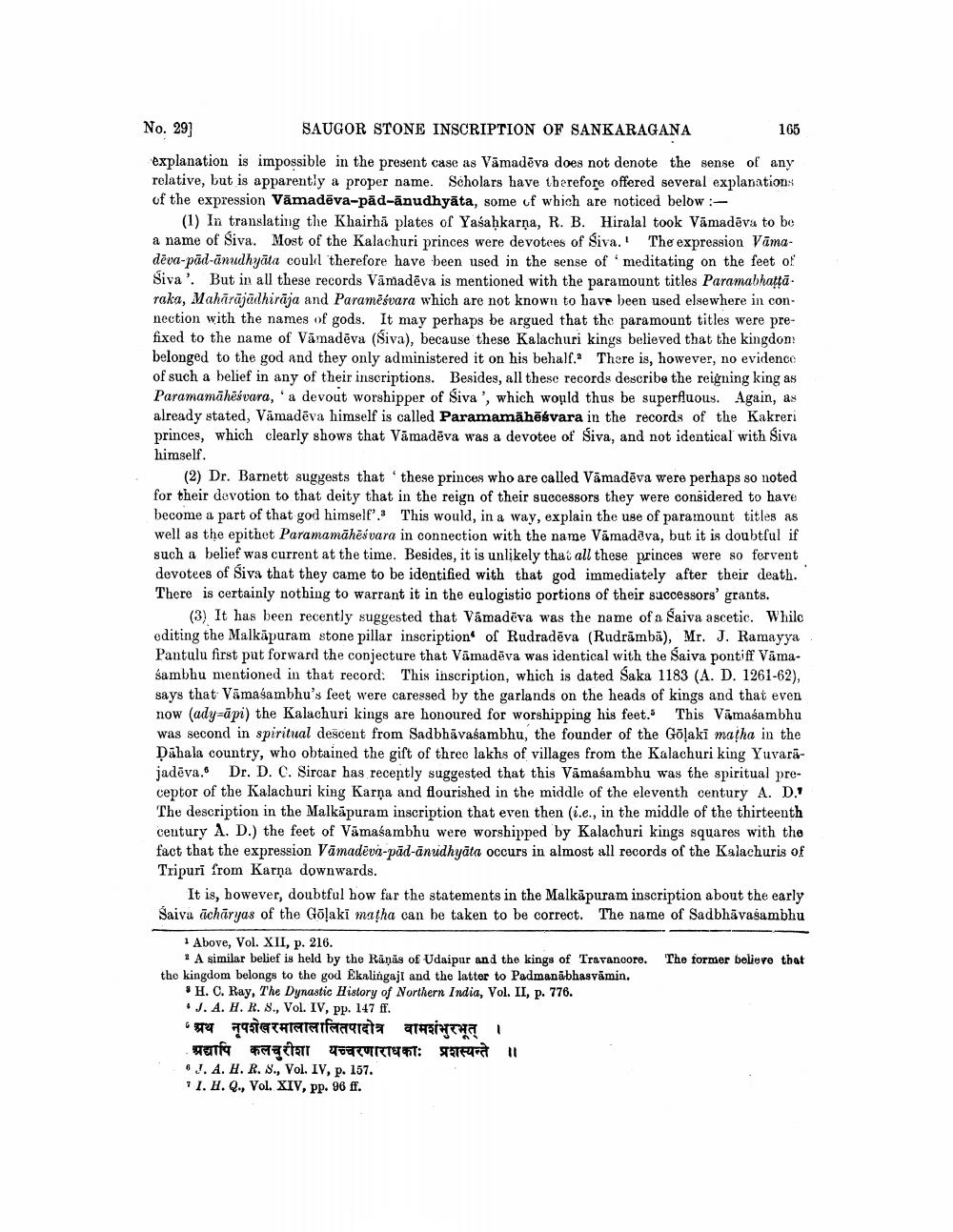________________
No. 29) SAUGOR STONE INSCRIPTION OF SANKARAGANA
165 explanation is impossible in the present case as Vāmadēva does not denote the sense of any relative, but is apparently a proper name. Scholars have therefore offered several explanations of the expression Vāmadēva-păd-ānudhyāta, some of which are noticed below:
(1) In translating the Khairhā plates of Yaśahkarna, R. B. Hiralal took Vāmadēva to be a name of Siva. Most of the Kalachuri princes were devotees of Siva. The expression Vāmadēva-pād-ānudhyāta could therefore have been used in the sense of meditating on the feet of Siva'. But in all these records Vāmadēva is mentioned with the paramount titles Paramabhattā. raka, Maharajadhirāja and Paramësvara which are not known to have been used elsewhere in connection with the names of gods. It may perhaps be argued that the paramount titles were prefixed to the name of Vamadeva (Siva), because these Kalachuri kings believed that the kingdon belonged to the god and they only administered it on his behalf. There is, however, no evidence of such a belief in any of their inscriptions. Besides, all these records describe the reigning king as Paramamāhësvara, 'a devout worshipper of Siva', which would thus be superfluous. Again, as already stated, Vämadēva himself is called Paramamāhāśvara in the records of the Kakreri princes, which clearly shows that Vamadeva was a devotee of Siva, and not identical with Siva himself.
(2) Dr. Barnett suggests that these princes who are called Vāmadēva were perhaps so noted for their devotion to that deity that in the reign of their successors they were considered to have become a part of that god himself'. This would, in a way, explain the use of paramount titles as well as the epithet Paramamāhësvara in connection with the name Vámadava, but it is doubtful if such a belief was current at the time. Besides, it is unlikely that all these princes were so fervent devotees of Siva that they came to be identified with that god immediately after their death. There is certainly nothing to warrant it in the eulogistio portions of their successors' grants.
(3) It has been recently suggested that Vámadēva was the name of a Saiva ascetic. While editing the Malkäpuram stone pillar inscription of Rudradēva (Rudrāmbā), Mr. J. Ramayya Pantulu first put forward the conjecture that Vāmadēva was identical with the Saiva pontiff Vāmasambhu mentioned in that record: This inscription, which is dated Saka 1183 (A. D. 1261-62), says that Vāmasambhu's feet were caressed by the garlands on the heads of kings and that even now (ady-āpi) the Kalachuri kings are honoured for worshipping his feet. This Vāmasambhu was second in spiritual descent from Sadbhāvasambhu, the founder of the Goļaki matha in the Dāhala country, who obtained the gift of three lakhs of villages from the Kalachuri king Yuvarājadēva. Dr. D. C. Sircar has recently suggested that this Vāmasambhu was the spiritual preceptor of the Kalachuri king Karņa and flourished in the middle of the eleventh century A. D.! The description in the Malkāpuram inscription that even then (i.e., in the middle of the thirteenth century A. D.) the feet of Vămasambhu were worshipped by Kalachuri kings squares with the fact that the expression Vāmadēvi-pād-ānudhyāta occurs in almost all records of the Kalachuris of Tripuri from Karna downwards.
It is, however, doubtful how far the statements in the Malkāpuram inscription about the early Saiva achāryas of the Gõlaki matha can be taken to be correct. The name of Sadbhāvasambhu
1 Above, Vol. XII, p. 216.
* A similar belief is held by the Rāņās of Udaipur and the kings of Travancore. The former believe that the kingdom belongs to the god Ekalingaji and the latter to Padmanābhasvamin.
* H. C. Ray, The Dynastic History of Northern India, Vol. II, p. 776. • J. A. H. R. 8., Vol. IV, pp. 147 ff. "अथ नृपशेखरमालालालितपादोत्र वामशंभुरभूत् । . अद्यापि कलचुरीशा यच्चरणाराधकाः प्रशस्यन्ते ॥ 6 J. A. H. R. S., Vol. IV, p. 157. 71. 4. Q., Vol. XIV, pp. 96 ff.




